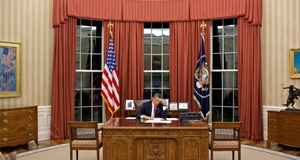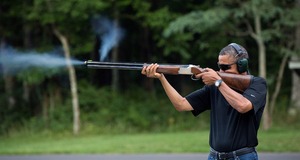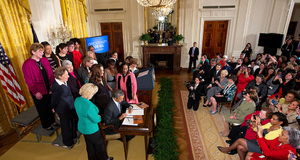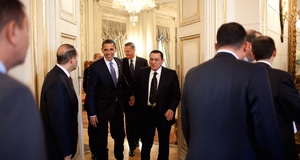The Obama PresidencyThe Urban President: Assessing Obama's Community Redevelopment Policies
By
2015, Vol. 7 No. 02 | pg. 3/3 | « Assessments and ConclusionsIn order to properly assess and draw conclusions on Barack Obama’s community development policies, it seems pertinent to revisit his signing of the My Brother’s Keeper Initiative. During the press conference, President Obama made an important statement that appears to encapsulate his personal, policy, and perhaps post-Presidency philosophy, where he stated, “That’s what My Brother’s Keeper is all about. Helping more of our young people stay on track. Providing the support they need to think more broadly about their future. Building on what works – when it works, in those critical, life-changing moments.68” Within the context of this key philosophical statement, how have these policy interventions faired? Full analysis of these programs is in their very early stages. As these issues cannot be fixed over night — even with injections of funding — long-term analysis and long-term advocacy are necessary. Barack Obama’s work experience as a community organizer on Chicago’s South Side, as well as his emphasis on community redevelopment policy and increasing the social mobility of urban African-American youth, may signal his Post-Presidency advocacy. However, despite the history of prolific Post-Presidency legacies, President Obama’s potential advocacy will be severely diminished if his predecessors do not maintain the added focus his administration placed on issues of community redevelopment. Commensurate with his mandate for change in America’s metros, President Obama’s policies have empowered governments, communities, and individuals to develop their communities from the inside out. Strong Cities, Strong Communities, Promise Zones, and My Brother’s Keeper are working to provide more opportunity for members of the urban poor community by giving them the chance to climb the ladder; to develop human capital in demographics most effected by the intergenerational transmission of disadvantage; to alleviate concentrations of poverty not by dispersing them but by organizing them from the inside-out through economic and community revitalization; and to make the federal government more accountable to both it’s constituents and state and local governments by acting as the catalyst for change and redevelopment, not just a distant institution setting policies.The dynamics of poverty and demographic changes in the United States appear to be in their early stages, and unlikely to reverse any time soon. It appears likely that the Obama Administrations shift toward regional economic policy and planning will remain, given that they have proven to be rather successful and have modernized national policy. However, this is merely a first step in the process. Sustainable, coherent, multi-level government response to community revitalization is necessary to make the country’s metropolitan areas more inclusive, and to provide greater opportunity for our most disadvantaged citizens. These three initiatives and the Obama Administration’s commitment in the area of urban community redevelopment have laid out important policy frameworks to address the marginalizing effects of poverty in the country’s cities, but continued implementation and further analysis will be needed to assess their long-term success. ReferencesCarpenter, Daniel. "Institutional Empowerment and Strangulation." Obama at the CrossroadsPolitics, Markets, and the Battle for America's Future (2012): 33-70. d'Addio, Anna Cristina. "Intergenerational transmission of disadvantage: mobility or immobility across generations?: a review of the evidence for OECD countries." (2007). Goldberg, Jonah. “In the case of My Brother’s Keeper, race does – and should – matter.” The Los Angeles Times, 4 March 2014. Hanlon, Bernadette, John Rennie Short, and Thomas J. Vicino. Cities and suburbs: New metropolitan realities in the US. Routledge, 2009. Ihlanfeldt, Keith R., and David L. Sjoquist. "The spatial mismatch hypothesis: a review of recent studies and their implications for welfare reform." Housing Policy Debate 9, no. 4 (1998): 849-892. Katz, Bruce, and Jennifer Bradley. The metropolitan revolution: How cities and metros are fixing our broken politics and fragile economy. Brookings Institution Press, 2013. Kneebone, Elizabeth, Carey Nadeau, and Alan Berube. "The Re-Emergence of Concentrated Poverty." The Brookings Institution Metropolitan Opportunity Series (2011). Philpot, T. S., Shaw, D. R., & McGowen, E. B. (2009). Winning the Race Black Voter Turnout in the 2008 Presidential Election. Public Opinion Quarterly, 73(5), 995-1022. Reeves, Richard. “Obama’s Post-Presidency? Tackling the Social Mobility Challenge for Black Men.” Brookings Institution Blog, 27 February 2014. Shulman, Robert. “New White House Office to Redefine Urban Policy.” The Washington Post, 3 July 2009. Wood, R. C. (1958). Metropolitan Government, 1975: An Extrapolation of Trends: The New Metropolis: Green Belts, Grass Roots or Gargantua?. American Political Science Review, 52 (01), 108. Endnotes1.) From the White House Press Release, Remarks by the President on “My Brother’s Keeper” Initiative. 27 February 2014. 2.) Philpot, Shaw, and McGowen, “Winning the Race.” 3.) Kneebone, Nadeau, and Berube, “The Re-Emergence of Concentrated Poverty.” 4.) Ibid. 5.) The concurrent increase in the phenomenon of suburban poverty is significant to note in the context of the economic recession and home mortgage crisis. Generally speaking, these suburbs are ‘inner-ring’ suburbs that have degraded over the course of recent decades with further and further metropolitan expansion outside of the center city. 6.) From the US Census Report on Voting and Registration in the Election of 2008, July 2012. 7.) Philpot, Shaw, and McGowen, “Winning the Race.” 8.) Ibid. In 2008, the black voter turnout rate was 65.2% to the 66.1% rate for white voters. 9.) It is important to note the distinction between eligible and registered voter status here. Statistics from the US Census Report on Voting and Registration in the Election of 2008, July 2012. 10.) Hanlon, Short, and Vicino, “Cities and Suburbs.” 11.) Ibid. 12.) From the US Census Report on Voting and Registration in the Election of 2008, July 2012. 13.) Katz and Bradley, “The Metropolitan Revolution.” 14.) Hanlon, Short, and Vicino, “Cities and Suburbs.” 15.) Ibid. 16.) Wood, “Metropolitan Government, 1975.” 17.) Ibid. 18.) From the US Census report on The Diversifying Electorate – Voting Rates by Race and Hispanic Origin in 2012, May 2013. 19.) Philpot, Shaw, and McGowen, “Winning the Race.” 20.) Ibid. 21.) Ibid. 22.) Ibid. 23.) Ibid. 24.) From the White House Office of Urban Affairs guiding principles statement, http://www.whitehouse.gov/administration/eop/oua/about/principles, accessed on 16 November 2014. 25.) From the BLS Report on The Recession of 2007-2009, in the “BLS Spotlight on Statistics,” February 2012. 26.) Ibid. 27.) Though the funding for TARP was legislated at $700 billion, the Dodd-Frank Act cut the appropriation to $475. See Carpenter, "Institutional Empowerment and Strangulation,"2012. 28.) Ibid. 29.) Kneebone, Nadeau, and Berube, “The Re-Emergence of Concentrated Poverty.” 30.) The federal poverty line as of August 2010 – keeping in line with the Brookings Institute analysis – was $22,050. Data from the Department of Health and Human Services, http://aspe.hhs.gov/poverty/10poverty.shtml 31.) Kneebone, Nadeau, and Berube, “The Re-Emergence of Concentrated Poverty.” 32.) Ibid. 33.) Ibid. 34.) Ibid. 35.) These basic goods include things like food, car insurance, and financial and health services. The increased price in these good directly affects a number of factors that lead to poor outcomes in communities of concentrated poverty. Notably, there is a large affect on diet related health outcomes due to the fact that healthy foods options – that are often not available because quality food markets often do not locate there – are made more expensive. 36.) Kneebone, Nadeau, and Berube, “The Re-Emergence of Concentrated Poverty.” 37.) Ibid. 38.) Ibid. 39.) Ibid. 40.) D’Addio, “Intergenerational Transmission of Disadvantage.” 41.) Reeves, “Obama’s Post-Presidency? Tackling the Social Mobility Challenge for Black Men.” 42.) Ihlanfeldt and Sjoquist, “The Spatial Mismatch Hypothesis.” 43.) Ibid. 44.) Ibid. 45.) Ibid. 46.) From the White House Urban and Economic Mobility mission statement, http://www.whitehouse.gov/issues/urban-and-economic-mobility, accessed on 16 November 2014. 47.) Ibid. 48.) Shulman, “New White House Office to Redefine Urban Policy,” 3 July 2009. 49.) From the White House Office of Urban Affairs guiding principles statement, http://www.whitehouse.gov/administration/eop/oua/about/principles, accessed on 16 November 2014. 50.) Ibid. 51.) From the White House Press Release, Executive Order – Establishing a White House Council on Strong Cities, Strong Communities, 15 March 2012. 52.) Ibid. 53.) From the First Annual Report on the Strong Cities, Strong Communities Initiative, April 2013. 54.) Ibid. 55.) Ibid. 56.) Donovan, “Supporting Local Communities by Building Capacity and Cutting Red Tape,” 25 April 2013. 57.) Ibid. 58.) Ibid. 59.) From the President’s remarks at the 2013 State of the Union Address, 12 February 2013, http://www.whitehouse.gov/the-press-office/2013/02/12/remarks-president-state-union-address. 60.) From the US Department of Housing and Urban Development Promise Zones Statement, http://portal.hud.gov/hudportal/HUD?src=/program_offices/comm_planning/economicdevelopment/programs/pz/overview, accessed on 22 November 2014. 61.) Ibid. 62.) From the “My Brother’s Keeper Task Force Report to the President,” May 2014. 63.) From the White House statement on “Getting Involved in My Brother’s Keeper,” http://www.whitehouse.gov/my-brothers-keeper, Accessed, 31 November 2014. 64.) From the “My Brother’s Keeper Task Force Report to the President,” May 2014. 65.) Ibid. 66.) Goldberg, “In the Case of My Brother’s Keeper race does – and should – matter,” 4 March 2014. 67.) Ibid. 68.) From the White House Press Release, Remarks by the President on “My Brother’s Keeper” Initiative. 27 February 2014. Suggested Reading from Inquiries Journal
Inquiries Journal provides undergraduate and graduate students around the world a platform for the wide dissemination of academic work over a range of core disciplines. Representing the work of students from hundreds of institutions around the globe, Inquiries Journal's large database of academic articles is completely free. Learn more | Blog | Submit Latest in Political Science |


















